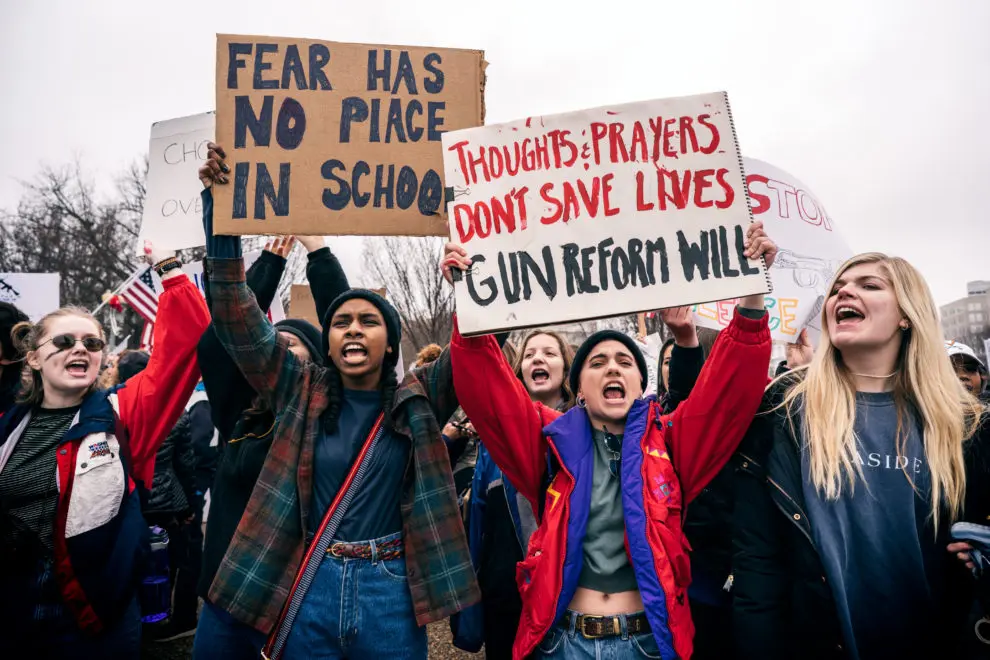 “Thoughts and Prayers Don’t Save Lives, student lie-in at the White House to protest gun laws” by Lorie Shaull is licensed under CC BY 2.0.
“Thoughts and Prayers Don’t Save Lives, student lie-in at the White House to protest gun laws” by Lorie Shaull is licensed under CC BY 2.0.
It was May 1963. The Civil Rights Movement in Birmingham, nicknamed “Bombingham,” Alabama for its violent explosions against protesters, began to wane after the arrest of Martin Luther King failed to attract new adult protesters, who feared losing their jobs, their only means of supporting their families. James Bevel, a local leader with the Southern Christian Leadership Conference, suggested recruiting school-aged children as protesters. Although initially opposed to the idea, Martin Luther King agreed, hoping to “subpoena the conscious of the nation to the judgment seat of morality.”
So, on May 2, 1963, more than 1000 African American youth, guided by the rightness of their cause, skipped classes, gathered at the Sixteenth Street Baptist Church and marched to downtown Birmingham where they were met by hostile crowds and police officers who arrested them and threw them in jail. So many children were arrested that day that city officials had to house them at the local fairgrounds, where they sang “We Shall Overcome.” Undeterred, the following day hundreds more children joined the protest. Bull Connor, the commissioner of public safety, directed police to beat the children, sick police dogs on them and blast them with high powered fire hoses, all on view for the nation and world to see.
“Pictures of the bravery and determination of the Birmingham children as they faced the brutal fire hoses and vicious police dogs were splashed on the front pages of newspapers all across America and helped turn the tide of public opinion in support of the Civil Rights Movement’s fight for justice,” recalled Marian Wright Edelman.
Under intense public pressure, Birmingham negotiated a truce with Dr. King and on May 10, Connor was removed from his position.
The Children’s Crusade worked. Historians credit it and the thousands of brave children with shifting public opinion in favor of the movement. Without the children, there would have likely been no March on Washington, no Civil Rights Act of 1963, no Voting Rights Act of 1965.
Fifty-five years later our nation is again learning the power of children to speak truth to justice. On March 24, millions of school-aged children are expected to join the March for Our Lives in over 658 events in local communities across the nation and in Washington, DC. Inspired by the bravery of the students at Stoneman Douglas High School in Florida where a gunman killed 17 people, the students are demanding that their lives and safety become a priority, and that we end gun violence in our schools and more broadly in their communities.
In its mission statement, the students boldly declare that they will “no longer risk their lives waiting for someone else to take action to stop the epidemic of mass school shootings.
The students are demanding that comprehensive and effective legislation be brought before Congress to address gun issues, so that there will be no future Sandy Hooks, Columbines, and Stoneman Douglases.
The students’ actions are already yielding results. Last week, against the objection of the powerful National Rifle Association, the Florida legislature passed and Governor Scott signed legislation that would raise the minimum age to purchase rifles from 18 to 21 and create a waiting period for the purchase of guns. The legislation, which is being challenged in court by the NRA, does not go far enough but it is a baby step in the right direction, something we have not seen in decades.
It’s time for Congress to act with meaningful school safety and gun control legislation aimed at preventing gun violence in schools and communities, and not piecemeal stopgap measures meant to placate the students. In Congress. for example, recent legislative proposals such as the STOP School Violence Act, which would create anonymous reporting systems and provide some funding for states and schools to develop threat assessments and intervention teams would do little to prevent guns from getting in the hands of students and others who intend harm. Likewise, the President’s school safety proposal, which would strengthen efforts to “harden schools” and establish a national commission to investigate ways to arm certain qualified teachers on a voluntary basis, fails to advocate for sensible gun controls, such as universal background checks or an increase in the age requirement to purchase a rifle, something that the president touted in talks with legislators but who has since walked back those components after meeting with the NRA.
These efforts fall far short of the transformative change that the students are calling for to end gun violence in their schools and communities. It will be up to the students and adults who support their advocacy to demand real action now. At First Focus, we join the children across the nation in their crusade for safer schools and communities, in their calls to not make school safety a partisan issue, and in their calls to protect children over guns. To accomplish this, we believe Congress must take concrete actions to:
- Require background checks on all gun sales
- Restore a ban on “military-style assault weapons”
- Ban gun magazines with capacities of more than 10 rounds
- Toughen penalties on people who sell guns to those who can’t have them
- Significantly increase funding for mental health treatment
- Collaborate with schools, educators, law enforcement, and others on school safety measures
We call on Congress, the President, and adults across our nation to stand with the children to say Not One More child will be lost to gun violence.
Congress should take note of these powerful voices that are calling on Congress and adults to do what is right for children.